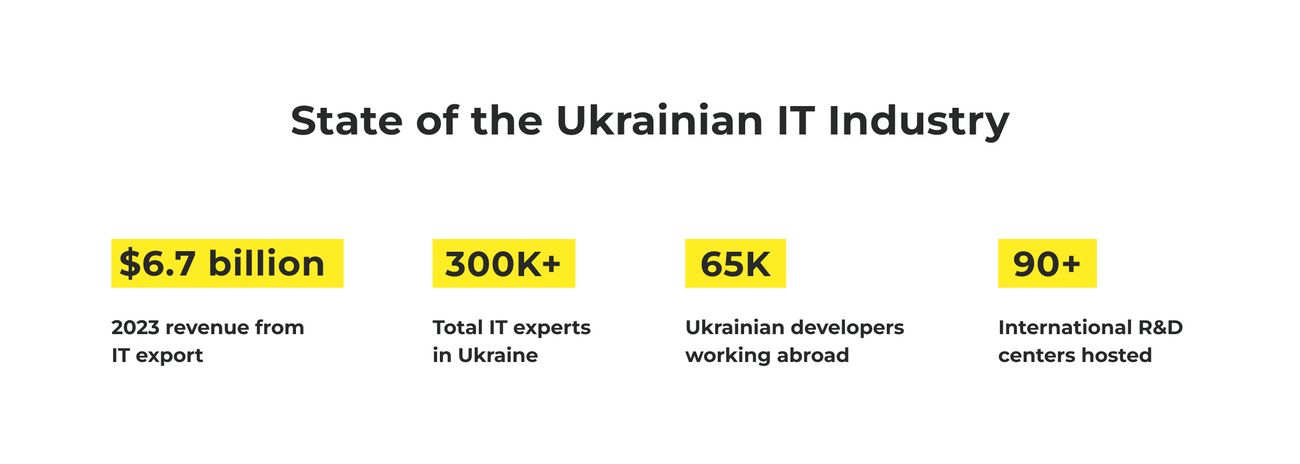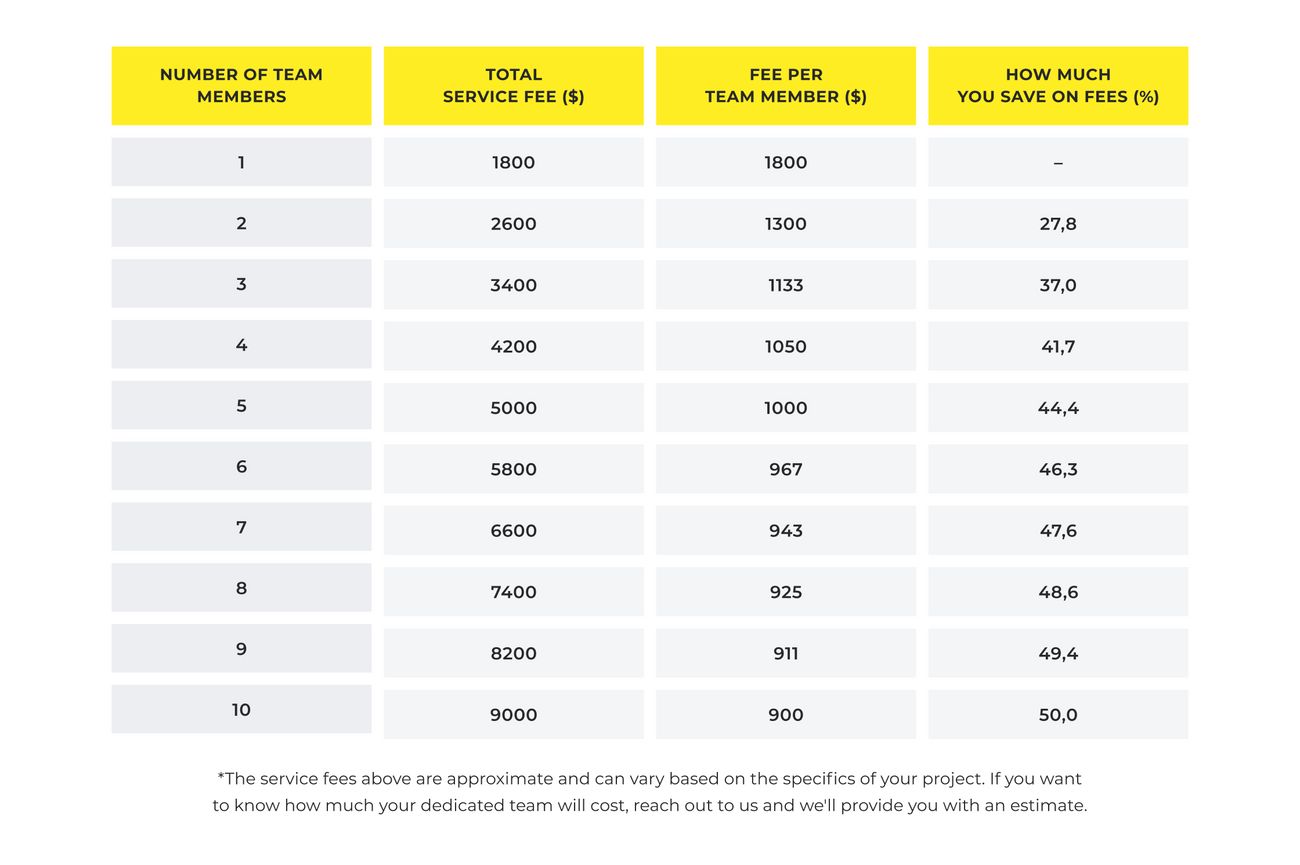In 2022, despite Russia starting a full-scale invasion, Ukraine witnessed the highest-ever value of IT exports. It reached $7.3 billion, $542 million more than the year before, reports say. How did it become possible, given the harsh political and economic situation?
The fact is that companies keep employing software developers in Ukraine, making the country one of the top destinations for hiring IT talent. In 2023, the number of tech specialists in Ukraine has grown by more than 7%, reaching a total of 307,600 professionals. Ukrainian software development expertise, work ethics, and affordable rates continue to attract companies looking to build software and augment their teams.
Ukraine is still at war with Russia. Given the circumstances, is it reasonable to hire Ukrainian developers in 2024? To answer this question, let’s see how the Ukrainian IT sector is doing right now.
Ukrainian software development: how is the situation in 2024?
The war does impact IT exports in Ukraine. Although we’ve seen the rise in Ukraine's value of IT services in 2022, the next year, exports decreased by $600 million. Such a fall is caused not just by the difficult political situation but also by the fact that many Ukrainian software developers have relocated and companies have opened new offices in Europe. Research reveals that 28% of Ukrainian CEOs aim to establish offices abroad with the most popular choice being Poland. The number of Ukrainian software developers working abroad has also grown, rising from around 55-57K last year to 65K in 2024, marking a 20% increase.
But while many Ukrainian developers have moved abroad, the majority still work within the country. Around 79% of the 307,600 tech professionals in Ukraine, or roughly 242K individuals, are still residing in Ukraine. They continue to work and innovate despite the ongoing situation.

The Russian invasion is still ongoing, which makes many businesses hesitate about hiring Ukrainian developers. To help you make an informed decision, let's look at some objections related to hiring software developers in Ukraine, and assess whether these concerns are well-founded.
Debunking 7 common myths about hiring Ukrainian developers
Let's take a look at 7 myths associated with the risks of hiring software developers in Ukraine and what the situation looks like in reality.
Myth #1: Raid air alerts postpone deliveries
One common misconception is that air alerts in Ukraine significantly disrupt developers' efficiency, not allowing them to work as intended. Air alerts are quite common, but the newest air defense systems minimize the impact of possible damages, keeping Ukrainians protected. Additionally, the government has been taking measures to help businesses stay afloat, including the building of shelters equipped with constant Wi-Fi connectivity.
Thanks to that, many companies resumed their regular work pace within a month after the war started, while our software development company managed to do that in just two weeks. So despite external pressures, Ukrainian developers continue to meet deadlines and show an unparalleled work ethic.
Myth #2: Developers have to relocate often
Another common concern is the potential need for developers to frequently relocate due to the ongoing war. However, the situation has remained stable for months. The majority of software developers, more than 80%, continue to work full-time.
As of May 2024, 18% of the Ukrainian territory is occupied by Russia – primarily in the eastern and southeastern regions. While the Russian bomb can fall anywhere, the majority of Ukraine remains relatively safe due to the effectiveness of air defense systems.
Additionally, the western regions of Ukraine offer a higher level of safety. For instance, the Transcarpathia region, located in the western part of Ukraine, is considered a safe haven. Many businesses and IT professionals have successfully moved there.
As of 2024, all Ukrainian developers wishing to move have already done it. Most of them live in the western regions or abroad, primarily in Poland, and continue to work from there.
Myth #3: Power outages affect team productivity
Another myth related to Ukrainian development teams is that they can't deliver projects on time due to power shortages. Shortages do happen as the country is trying to preserve its power resources, but businesses have proactively addressed this issue.
For instance, many companies have acquired power generators that ensure operational continuity even during blackouts. What's more, many companies are using Starlink which allows them to have Internet connectivity 24/7. Kultprosvet is among those companies. We have invested in alternative power sources to avoid blackouts.
"We are still dealing with energy shortages but that's not a big deal to equip one's working space with alternative power sources and Starlink. We did so, as well as most of the businesses around."
Anton Trakht, CEO at Kultprosvet
Such precautions ensure that developers in Ukraine can continue working effectively despite electricity challenges.
Myth #4: High risks of cyber attacks
The ongoing conflict, in addition to physical attacks, has increased the risk of cyber attacks. But as they say, every cloud has a silver lining. This threat has led to advancements in cybersecurity measures and strengthened the resilience of digital infrastructure in Ukraine.
According to Gartner, the increased risks have spurred substantial research in cyber defense across both business and government institutions in Ukraine. As a result, software development in Ukraine has become particularly strong in areas such as cybersecurity, the Internet of Things (IoT), AI, and cloud computing.
Ukrainian IT companies have transferred critical data to secure cloud environments, enhancing their resilience against potential threats and implementing robust security protocols to adhere to the highest international standards.
Myth #5: There is a tech talent shortage
Despite the conflict's impact, the Ukrainian tech talent pool continues to grow. The industry has seen an influx of well-educated newcomers, thanks to collaborative efforts between the government and the business community.
As of 2023, the number of tech specialists has grown by over 7%, now totaling 307,600. Of these, 242,000 live and work in Ukraine, with a record number of students having enrolled in IT-related programs in 2022.
By the way, Ukrainian tech talent has long played crucial roles in the US and European tech ecosystems. The Kyiv Polytechnic Institute, in particular, has produced a substantial number of graduates working across Europe. It also boasts the second-largest number of female tech graduates in Europe. Overall, Ukrainian software developers comprise 25% of women, compared to the European average of 16%.
Ukraine is currently the fourth-largest supplier of tech talent in the world, with an increasing number of outsourcing companies. Ukraine’s dedicated developers bring expertise across various domains and technologies, thanks to their experience collaborating with clients from around the world.
"We have daily check-ins directly with the team. The senior developer is our team lead and direct contact, and we have a project manager who bounces off around the meetings. Overall, we’re very connected, especially with everything happening in the country with the Russian invasion. It’s important to stay close at the moment."
Kevin Hill, Senior Director of Technology & Data Strategy, SuperOrdinary
In 2023, Ukraine ranked first out of 169 countries in the Science and Technology category of The Good Country Index.
Myth #6: Ukrainian developers are in the army
Although Ukrainians have shown great bravery during the war and the country has seen a large number of those who voluntarily decided to go to the army, the majority of Ukrainian programmers are fighting the war differently: by focusing on cybersecurity and information safety.
According to a survey of 30 IT companies, all members of the Association of IT Ukraine, in smaller companies with up to 200 employees, only 20% of specialists have joined the military. Meanwhile, 5% of IT professionals are actively contributing to the information front, focusing on state cybersecurity and maintaining critical infrastructure.
Myth #7: Customers have abandoned Ukraine
There's a common perception that customers left Ukraine after the war had started. However, this couldn't be further from the truth.
In fact, according to Sequoia, only 16% of tech companies lost more than 10% of their customers; 52% managed to retain them all. Just 2% of Ukrainian IT firms have had to shut down in these difficult times.
At KPS, we’ve faced challenges since the war began, but we’re grateful for the ongoing support from our clients. One client shared their experience:
“Despite the challenging events, including Ukraine's ongoing conflict since February 24, 2022—the very date our Waddington’s app was scheduled for launch—our partnership has remained strong. Not once in two years have any of the challenges they face every day affected the work, projects, or timeframe. They continue to deliver exceptional results.”
Iryna Stankevich, Technical Product Manager, Waddington's Auction House
Read more reviews from our clients on Clutch.
Now that we have demystified the main concerns about hiring software developers in Ukraine, let’s get more specific and answer one of the most important questions for any business. How much does it cost to hire Ukrainian developers?
How much does it cost to hire developers from Ukraine?
There are several options for hiring Ukrainian software developers. Basically, you can go through a software development outsourcing company, or look for freelancers and hire them independently.
If your project is small or short-term, hiring freelancers on platforms like Upwork and Toptal might be a cost-effective option. But keep in mind that managing freelancers often requires hands-on oversight. You’ll need to dedicate significant time and effort to finding, hiring, and managing them.
For more complex projects or long-term collaborations, it's better to work with an established IT company. There are more than 2000 software development companies in Ukraine, the majority of which work with US-based companies.
Hiring Ukrainian software developers vs USA: Developer salary comparison
Many companies, particularly in the US, tend to hire development teams in Ukraine because of their price competitiveness. Sure, it sounds convenient to have your team members work in the same office, with you being able to communicate with ease. But this luxury can cost you a lot.
For a better understanding, here's a list of the most sought-after IT job roles in the US over the past 2 years and how their monthly salaries compare to their Ukrainian counterparts. Take a look:

However, the final price you will pay for an in-house employee goes beyond their salary. You should also include bonuses, insurance, taxes, and so on. The cost difference will be even more visible.
For example, let’s consider the case of one of our clients, Liquidity Capital. Looking to develop an AI-driven asset management platform, they wanted to hire a dedicated team with 2 senior full-stack developers, 1 tech Lead for the back end, and 3 senior PHP developers. Had they hired a dedicated team in the US, they would have paid $61,917 monthly. Being an early-stage startup at that time, Liquidity Capital was looking for a more budget-friendly option, so they chose Ukraine as a promising destination and teamed up with us to find the required specialists.
Our team quickly assembled a team of experts that fully matched the client’s requirements. As a result, the monthly team budget was cut down to $24,500, which is 2,5 times less compared to hiring the same team in the US.
But what’s more important, with our help, Liquidity Capital managed to deliver their product according to their vision and reach unicorn status. Read more in our case study.
As you might have guessed, KPS is a software development company. We offer three different engagement models, each with its own benefits. Here is a brief overview:
Time & Material (T&M)
If you need to bridge talent gaps quickly, the T&M model will suit you perfectly. Whether you need software developers, or experts in AI, blockchain, cybersecurity, or any other area, we can quickly connect you with our in-house developers as well as top talent from our curated database of over 16K candidates.
This flexible model allows you to pay only for the hours worked by the developers and any materials required for the project. It’s ideal for projects where the scope might change, as you can adjust resources as needed. Our rates are typically between $35 to $45 per hour.
Developer salaries + our monthly fee
This option suits businesses looking for a scalable team for long-term engagement. We provide a dedicated software development team from Ukraine, manage all recruitment processes, and handle administrative tasks, allowing you to focus on your business. You pay the developer's salary, plus a monthly service fee for our management and support services.

We operate on a dynamic loyalty system where the more team members you add, the lower your overall costs become.

Fixed-price or fixed-scope
If you need end-to-end software development, this model will fit you perfectly. We take full ownership of the project lifecycle while you share your requirements and set the direction for us to follow.
In this case, we agree on a fixed price for a clearly defined scope of work. The cost depends on the project's scope and complexity.
To conclude, here’s what you get with each of our engagement models:

To sum up
Despite the ongoing challenges, Ukraine's developers and businesses are no way near throwing in the towel. The Ukrainian IT industry managed to adapt to the hard times and remains one of the country’s major export sectors. Ukrainian software development teams do their best to meet the needs of their clients, contributing to the future victory.
At Kultprosvet, we are no exception to this trend. This year, we successfully built five new dedicated teams and managed over 30 projects, delivering high-quality products even under challenging conditions. So if you want to hire software engineers, we’re here for you.
Resources:
The Power of Ukrainian IT—Research for 2023
IT services export value Ukraine 2023 | Statista
Tech Industry Dynamics Amidst War: Findings of IT Research Ukraine 2023 - Lviv IT Cluster
In 2023, Ukrainian IT Services Export Faced Its First Decline in Years - Асоціація "IT Ukraine"
Market Guide for Ukrainian Information Technology
Ukrainian Talent Proves Resilient
Russian-occupied territories of Ukraine - Wikipedia
Company Salaries Worldwide - Glassdoor
